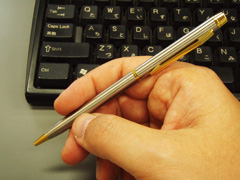Titanium is human-friendly, excellent biocompatibility
Metal ionizes with sweat and body fluids and rubs allergy, but titanium is not.
Titanium is kind to people.
Made with titanium, it becomes a safe item.
Excellent biocompatibility of titanium
Please take a look around yourself before proceeding. How many pieces of metal are around you?
... There are quite a few.
Metal products are enjoyable and enriching our lives with various shapes, colors, gloss, functions, etc. Lifestyles without metal products are no longer considered.
Although it is such a convenient metal, it may be harmful depending on usage. In particular, you must be careful when using it on the skin (accessories etc.) or when implanting in the body (medical equipment etc). Let's take a closer look.
For example, when the body's function declines, we try to supplement its function using various instruments. Glasses, hearing aids, dentures and so on are so. And if the complementary function is inside the body, you will use the instrument embedded in the body. It is an artificial bone, an artificial joint, an implantable cardiac pacemaker, etc.

After writing instruments with titanium ...?
There is no worry about metal allergy even if it is caught in the ear.
It looks fine and is lighter than I thought.
The texture will not be impaired even after 100 years.
Now, what would you make with titanium?
Metal is strong and has good formability, so it is a place you want to make strength, especially bones and joints, where strength is necessary, but of course you can not use it if there is harm to the body. Many metals ionize and sweat with perspiration and body fluids, which can cause allergies, or in severe cases lead to breakage.
However, titanium binds with oxygen to instantly form a strong passive film on the surface, and even if it gets scratched for some reason it instantly reforms and does not dissolve out the passive film. In addition, even if titanium ions are eluted for some reason, they will immediately oxidize and will not adversely affect the human body.
In other words, it means that titanium is a safe metal so that it can be embedded in the body.
↓ Click here if you want to make use of it to work or products here ↓
How titanium is used in the body
Let's go further, let's see how titanium is used for bones and joints.
Damage due to joint pain and accident accompanying rheumatoid arthritis, you may have to use artificial bones or artificial joints. Since bones and joint parts need strength, it is not enough just to say that they are safe materials. And, as for strength, it is necessary to consider not only the strength of itself but also the strength of the joint part with the bone.
Osteogenesis reactions around artificial bones and artificial joints are classified as follows.
(1) Interstitial bone formation: A thick fibrous tissue is formed at the boundary between artificial bone and the like and bone.
② Contact osteogenesis: Bone formation occurs in close contact with artificial bone and the like.
③ Bonding osteogenesis: Bone formed and artificial bone etc. are directly bonded.
Titanium is actually used for implants that replace teeth. Titanium has an excellent affinity of being combined with the jawbone.
With respect to metallic artificial bones and the like, stainless steel etc. is classified into interstitial bone formation and titanium is classified as contact osteogenesis. Titanium is closely attached to bone tissue at the optical microscopic level (called osseointegration), but at the electron microscopic level it is known that soft tissue exists at the boundary with bone, and most of the metallic materials are biocompatible Although it is excellent, it is not directly bonded to bone like ceramics material.
Therefore, it took about 10 to 15 years to replace, but in recent years, a surface treatment has been developed that provides robust connectivity with living bones and the way of using prostheses for a long time has opened up.
Aluminum · dilute hydrochloric acid · heat treatment on titanium porous body forms a layer of anatase and rutile firmly bonded to the surface and entangled with net mesh shape. This will react with body fluids and form apatite layers to cover them. Since it is the same type as apatite in living bone, it firmly bonds with bone and it stabilizes for a long time.
In other words, it directly bonds with hard bones and integrates them.
It can be said that the body acknowledged it as a friend.
In addition, ceramics materials that form connective bone formation are not used because they have strength problems for use in artificial joints. Titanium can be safely used for a long period of time even for medical instruments implanted in the body like this.
Accessories and other, even jewelry that you attach directly to the body, of course, this effect can be expected and can be said as a very reliable material. Especially pierced earrings are used where punctures are used in the body, so safety is highly required.
Metals ionized by sweat may cause allergies, even for things that are used in sticky conditions, such as rings and necklaces.
Incidentally, metals that are prone to allergies are mercury, nickel, cobalt, tin, palladium, chromium, copper, etc. However, depending on the person, care must be taken as all other metals may cause other metals.
Even in such applications titanium remains outstanding and remains safe.
And, titanium products that are safe for the body simultaneously demonstrate other characteristics such as light, strong, rusty and beautiful.
To you who thought that I would like to make it with titanium
 Phone number: 0480-22-3301
Phone number: 0480-22-3301 Fax number: 0480-22-8818
Fax number: 0480-22-8818